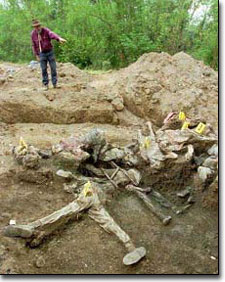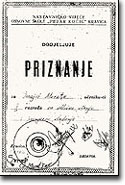


Stage 2 - Visits Graves
August 14-16, 1995
Articles: "Graves
Found That Confirm Bosnia Massacre"
"Evidence Indicates Bosnia Massacre"
Determined to find the graves depicted in the CIA surveillance photo, David Rohde returned to Belgrade and obtained a fax copy of the photo from his editor, Faye Bowers. He hurried back to the Serb-occupied sector as quickly as possible. He had what he needed to locate the graves. But, it was mid-August, only one month after the alleged atrocities took place, so safety was an issue. Serb soldiers guarded the border and patrolled the area where the graves were located. Muslim guerrillas still fought in the hills surrounding Srebrenica. Potential imprisonment or death were possibilities Rohde had to take into account.
On Aug. 16, 1995, Bosnian Serb officials authorized Rohde to drive to Pale, the Bosnian capital. Defying explicit Serb orders to go to Pale, Rohde instead stopped in Nova Kasaba, which the CIA had identified as the site of the suspected mass graves.

Rohde investigated the area on foot for two hours, using a blurred, faxed copy of one of the satellite surveillance photos. In that time he located no fewer than four areas of fresh digging. Abundant, undeniable forensic evidence of mass executions was strewn over a quarter-mile swath.
It included empty ammunition boxes, spent shell casings, an elementary school diploma with a Muslim name, washed-out personal photographs, notes from a Srebrenica town meeting, and decomposed human bones in tattered clothing that poked above earth.
The largest of the possible mass graves was as long as a football field and equally wide. The smallest was 50 x 100 feet. They matched the photos perfectly.
Rohde collected documents and what photos he could find to substantiate his conclusions. Aware that Serb officials and others would try to discredit his story and challenge what he saw, Rohde was meticulous about documenting the evidence. He and his translator (herself a doctor) visited a veterinary university to confirm that the bones he saw were not those of cows or horses, but were human. It all checked out.
The chief of a war crimes investigation team, William Haglund, showed the press a mass grave of at least 12 corpses in July 1996 at a site in Nova Kasaba. Photo: AP
With one piece of the puzzle in place, it remained for Rohde to track down survivors or other eyewitnesses to corroborate the forensic proof of Serb-sponsored genocide and other war crimes.
Despite the ample, compelling evidence available and Albright's presentation signaling the abuse, no other journalists were on to the story. That changed when Rohde's first piece ran on the Monitor's front page, on Friday, Aug. 18, 1995.

A school diploma found at a gravesite by Rohde in August, was identified as belonging to one of the missing men from Srebrenica. Photo: Christian Science Monitor